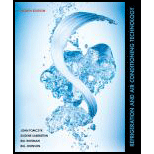
Refrigeration and Air Conditioning Technology (MindTap Course List)
8th Edition
ISBN: 9781305578296
Author: John Tomczyk, Eugene Silberstein, Bill Whitman, Bill Johnson
Publisher: Cengage Learning
expand_more
expand_more
format_list_bulleted
Concept explainers
Textbook Question
Chapter 2, Problem 17RQ
At a constant pressure, how does a volume of gas vary with respect to the absolute temperature?
Expert Solution & Answer
Trending nowThis is a popular solution!

Students have asked these similar questions
Solve this problem and show all of the work
Practice
L[sin at]
Find the Hertzian stresses and the maximum shear stress for the wheel.
Chapter 2 Solutions
Refrigeration and Air Conditioning Technology (MindTap Course List)
Ch. 2 - Matter is a substance that occupies space and has...Ch. 2 - What are the three states in which matter is...Ch. 2 - ________ is the term used for water when it is in...Ch. 2 - In what direction does a solid exert force?Ch. 2 - In what direction does a liquid exert force?Ch. 2 - Vapor exerts pressure in what direction? A....Ch. 2 - Define density.Ch. 2 - Define specific gravity.Ch. 2 - Describe specific volume.Ch. 2 - Why does an object weigh less on the moon than on...
Ch. 2 - The density of tungsten is 1210 lb/ft3. What would...Ch. 2 - The specific volume of red brass is 0.001865...Ch. 2 - Aluminum has a density of 171 lb/ft3. What would...Ch. 2 - Four pounds of a gas occupy 10 ft3. What would be...Ch. 2 - Why is information regarding the specific volume...Ch. 2 - Whose law states that the volume of a gas varies...Ch. 2 - At a constant pressure, how does a volume of gas...Ch. 2 - Describe Dalton's law as it relates to a confined...Ch. 2 - What are the two types of energy most frequently...Ch. 2 - How were fossil fuels formed?Ch. 2 - Prob. 21RQCh. 2 - Prob. 22RQCh. 2 - If an air-conditioning compressor weighing 300lb...Ch. 2 - Describe horsepower and list the three quantities...Ch. 2 - How many watts of electrical energy are equal to 1...Ch. 2 - How many Btu of heat can be produced by 4 kWh...Ch. 2 - How many Btu/h would be produced in a 12-kW...Ch. 2 - What unit of energy does the power company charge...Ch. 2 - If 3000 ft3 of air is crossing an evaporator coil...Ch. 2 - A gas is compressed inside a compressor's...
Knowledge Booster
Learn more about
Need a deep-dive on the concept behind this application? Look no further. Learn more about this topic, mechanical-engineering and related others by exploring similar questions and additional content below.Similar questions
- Can I get help on this question?arrow_forwardDuring some actual expansion and compression processes in piston–cylinder devices, the gases have been observed to satisfy the relationship PVn = C, where n and C are constants. Calculate the work done when a gas expands from 350 kPa and 0.03 m3 to a final volume of 0.2 m3 for the case of n = 1.5. The work done in this case is kJ.arrow_forwardCarbon dioxide contained in a piston–cylinder device is compressed from 0.3 to 0.1 m3. During the process, the pressure and volume are related by P = aV–2, where a = 6 kPa·m6. Calculate the work done on carbon dioxide during this process. The work done on carbon dioxide during this process is kJ.arrow_forward
- The volume of 1 kg of helium in a piston–cylinder device is initially 5 m3. Now helium is compressed to 3 m3 while its pressure is maintained constant at 130 kPa. Determine the initial and final temperatures of helium as well as the work required to compress it, in kJ. The gas constant of helium is R = 2.0769 kJ/kg·K. The initial temperature of helium is K. The final temperature of helium is K. The work required to compress helium is kJ.arrow_forwardA piston-cylinder device initially contains 0.4 kg of nitrogen gas at 160 kPa and 140°C. Nitrogen is now expanded isothermally to a pressure of 80 kPa. Determine the boundary work done during this process. The properties of nitrogen are R= 0.2968 kJ/kg-K and k= 1.4. N₂ 160 kPa 140°C The boundary work done during this process is KJ.arrow_forward! Required information An abrasive cutoff wheel has a diameter of 5 in, is 1/16 in thick, and has a 3/4-in bore. The wheel weighs 4.80 oz and runs at 11,700 rev/min. The wheel material is isotropic, with a Poisson's ratio of 0.20, and has an ultimate strength of 12 kpsi. Choose the correct equation from the following options: Multiple Choice о σmax= (314) (4r2 — r²) - о σmax = p² (3+) (4r² + r²) 16 σmax = (314) (4r² + r²) σmax = (314) (4² - r²)arrow_forward
- I don't know how to solve thisarrow_forwardI am not able to solve this question. Each part doesn't make sense to me.arrow_forwardExercises Find the solution of the following Differential Equations 1) y" + y = 3x² 3) "+2y+3y=27x 5) y"+y=6sin(x) 7) y"+4y+4y = 18 cosh(x) 9) (4)-5y"+4y = 10 cos(x) 11) y"+y=x²+x 13) y"-2y+y=e* 15) y+2y"-y'-2y=1-4x³ 2) y"+2y' + y = x² 4) "+y=-30 sin(4x) 6) y"+4y+3y=sin(x)+2 cos(x) 8) y"-2y+2y= 2e* cos(x) 10) y+y-2y=3e* 12) y"-y=e* 14) y"+y+y=x+4x³ +12x² 16) y"-2y+2y=2e* cos(x)arrow_forward
- Qu. 15 What are the indices for the Plane 1 drawn in the following sketch? Qu. 16 What are the Miller indices for the Plane shown in the following cubic unit cell? this is material engineering please show all workarrow_forwardI do not understand how to approach this question. I tried to answer it but I kept getting it incorrect.arrow_forward(read image)arrow_forward
arrow_back_ios
SEE MORE QUESTIONS
arrow_forward_ios
Recommended textbooks for you
 Refrigeration and Air Conditioning Technology (Mi...Mechanical EngineeringISBN:9781305578296Author:John Tomczyk, Eugene Silberstein, Bill Whitman, Bill JohnsonPublisher:Cengage Learning
Refrigeration and Air Conditioning Technology (Mi...Mechanical EngineeringISBN:9781305578296Author:John Tomczyk, Eugene Silberstein, Bill Whitman, Bill JohnsonPublisher:Cengage Learning

Refrigeration and Air Conditioning Technology (Mi...
Mechanical Engineering
ISBN:9781305578296
Author:John Tomczyk, Eugene Silberstein, Bill Whitman, Bill Johnson
Publisher:Cengage Learning
Thermodynamics: Maxwell relations proofs 1 (from ; Author: lseinjr1;https://www.youtube.com/watch?v=MNusZ2C3VFw;License: Standard Youtube License